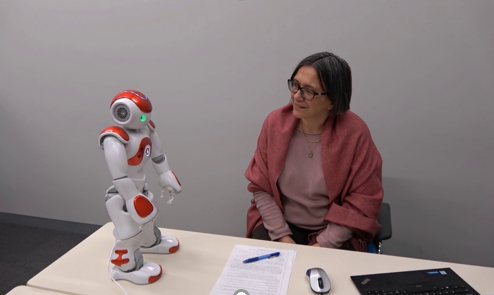Kristiina Jokinen
Senior Researcher, AI Research Center AIST Tokyo Waterfront, Japan
Adjunct Professor, University of Helsinki, Finland

What kind of research are you currently engaged in?
I work at the Artificial Intelligence Research Center of the National Institute of Advanced Industrial Science and Technology (AIST) in Tokyo Waterfront.
My research area is Human-Robot Interaction, and in particular, I work on Social Robotics to model natural social interaction between humans and robots. The goal of my research is to enable communication between humans and robots in applications and services where language-based interaction is useful and feasible. Educational or coaching systems where the robot provides help and instructions, assists the user in everyday tasks, and just provides interesting information to the user are examples of such social robot applications. Social interaction includes spoken language and also multimodal aspects like hand gesturing, head nodding, body posture, and gaze. These modalities convey important information in interactions, the so-called social signals that guide the participants on issues like emotions and affective state of the dialogue partner, where the partners focus their attention to, and also help in the coordination and collaboration of interaction. Moreover, issues related to knowledge are important: how to represent it and how to acquire it. Dialogue modelling can be done manually by scripting suitable scenarios, but a lot of current research focuses on AI-based techniques such as neural modelling and big data which are also the main areas in the AI Research Center at AIST.
How did you get interested in Social Robotics and Human-Robot Interaction?
My background is in natural language processing and dialogue modelling, and issues related to human-human and human-computer interaction always fascinated me. As research in robotics advanced, autonomous humanoid robots started to move out from research labs and appear in the real world as robust working robots. I had an opportunity to work on the Nao humanoid robot and build an application that allows the user to talk to a robot and look for Wikipedia information. The WikiTalk application was then followed by the MoroTalk application that could read online news, and the SamiTalk application to experiment with robots in language revitalisation. The research area is vast and interdisciplinary, and covers research from technical aspects to language processing, from social acceptance to useful applications.

How did you end up in Japan and at your current institution?
I did my PostDoc at Nara Institute of Science and Technology, thanks to the JSPS Postdoc Fellowship. After that I was two years as Invited Researcher at the ATR Telecommunication Labs in Kyoto, and even after returning back to Europe I had good collaboration with colleagues I met during my Fellowship time, and visited Japan for shorter and longer periods on conferences and invitations. Of course, Japan is one of the leading countries in robotics and AI research, with an open-minded and creative attitude towards social robots in general. When I learnt about openings at AI Research Center at AIST, I did not hesitate to send in my application, and so here I am.
How do you experience the research environment in Japan compared to Finland?
Japanese work environment is much more guided by various procedures, which for a foreigner may not always be so clear and straightforward to understand. Also, various forms and regular reporting may make decisions seem slow and strict, and of course hierarchy is much more interwoven even in the language itself. On the other hand, it can also provide a good feeling to know that if a procedure is started, it can also be successfully finished, any issues will be clarified and sorted out quickly, and there is certain responsibility towards colleagues. Japanese colleagues are very polite, helpful, and cooperative, they avoid open confrontation and are very flexible, and they do have a great sense of humour! Also, I think that living in a country where one minute shaking of the earth can destroy your whole life gives people kindness and sense of the life’s fragility.
How do you experience the lifestyle in Japan?
Well, I think I’ve already lived too long in Japan as I find it very natural! I also think that Finnish and Japanese life has many similarities, starting from taking your shoes off inside your home, to the importance of nature and the four seasons, and a certain reservedness and quietness in the character.

What do you do during your time off and where do you recommend travelling?
I practice Aikido, jog around Odaiba and the nearby canal and seaside paths, and read Japanese literature (from Man’yoshu to Doraemon). I also like travelling and visiting old temples, castles, and historical places, and before COVID-19 I had extensively travelled all around the four main islands and smaller islands as well, so now, when travelling is not recommended, it is actually not so bad. I’m biased towards Nara since it is the first place I learnt to know in Japan, but I can also recommend Tohoku area as well as Shikoku, and, of course, the Odaiba area where we live is pretty amazing like a seaside resort with hi-tech companies, robot trains, and the future Olympic venues!
Do you have any advice for researchers who dream of going to Japan?
Japan is a country of contradictions: old-new, fast-slow, rich-modest, disciplined-indulgent. Keep your dream going, and when you actually reach your goal, be open-minded, Japan will surprise you.


Academic background
Kristiina Jokinen is Senior Researcher at AI Research Center, AIST Tokyo Waterfront, and Adjunct Professor at University of Helsinki.
Before joining AIRC, she was Professor and Project Manager at University of Helsinki and at University of Tartu. She received her PhD from UMIST, Manchester, and was awarded a JSPS Fellowship to research at NAIST Japan.
She was Invited Researcher at ATR Research Labs in Kyoto and Visiting Professor at Doshisha University in Kyoto in 2009-2010. She was Nokia Foundation Fellow in Stanford in 2006, and she is Life Member of Clare Hall at University of Cambridge.
